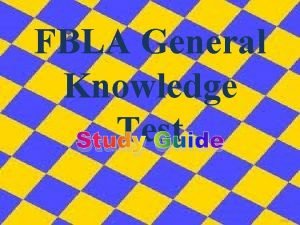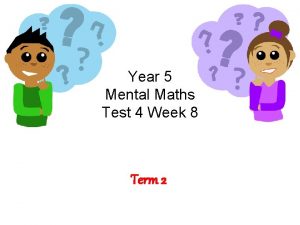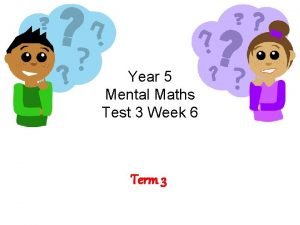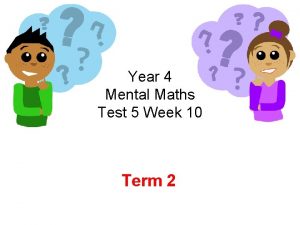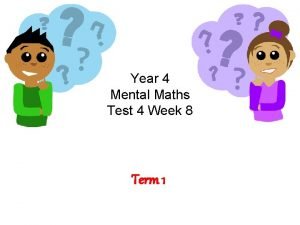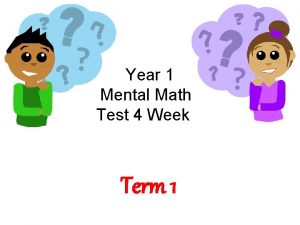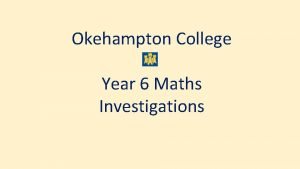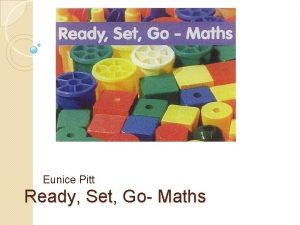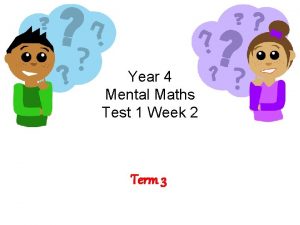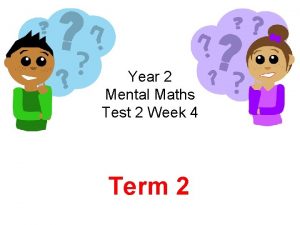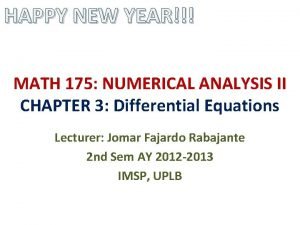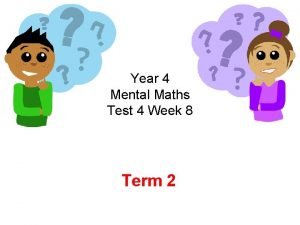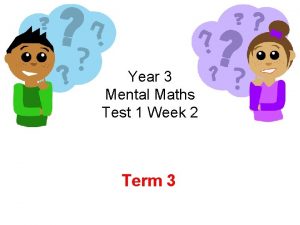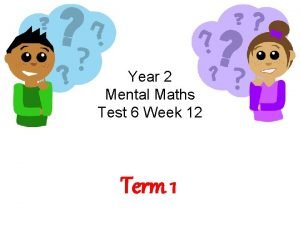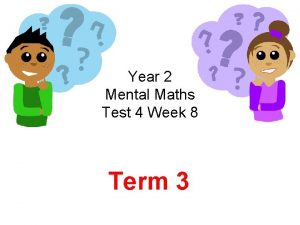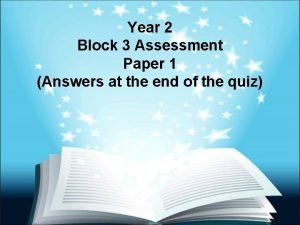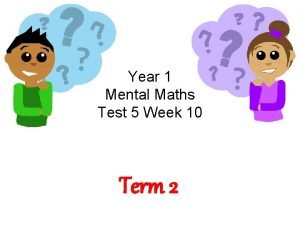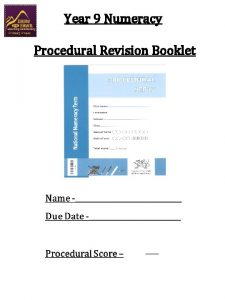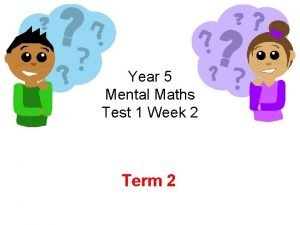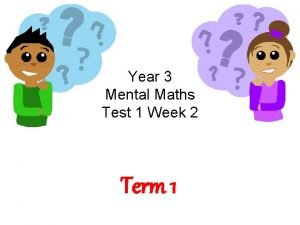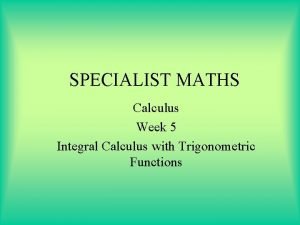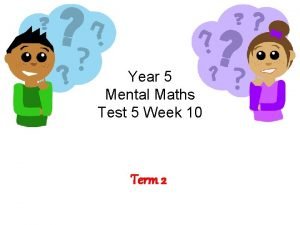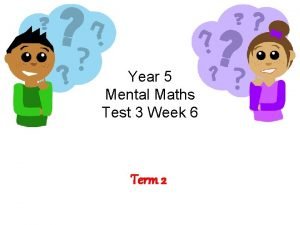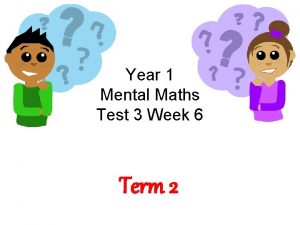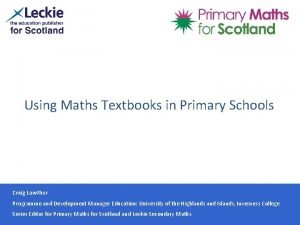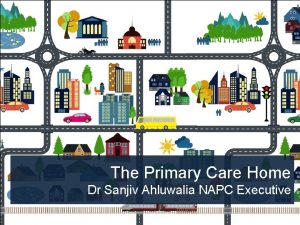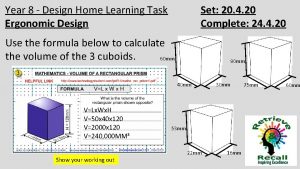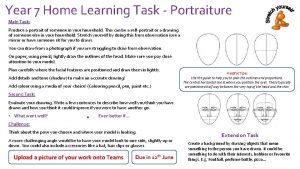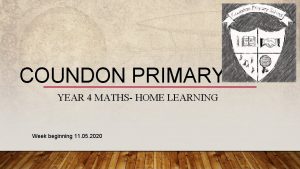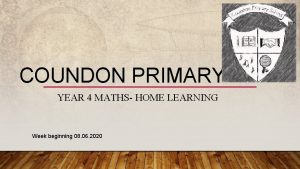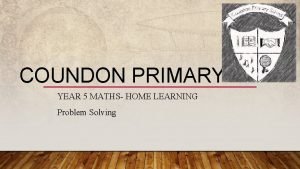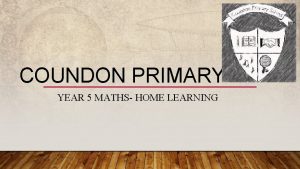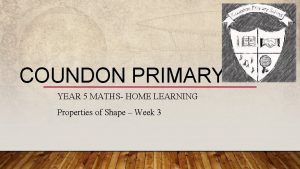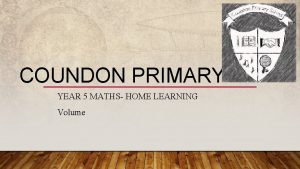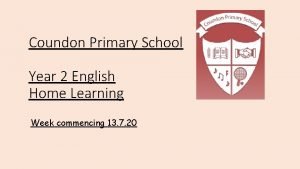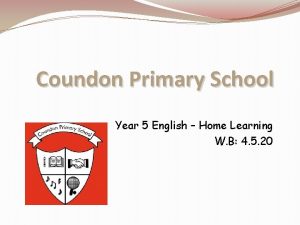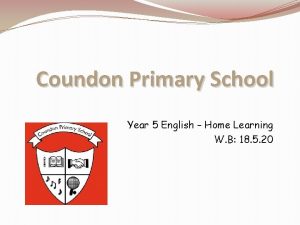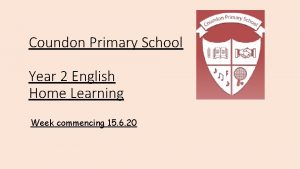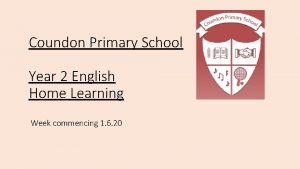COUNDON PRIMARY YEAR 4 MATHS HOME LEARNING WEEK






















































- Slides: 54

COUNDON PRIMARY YEAR 4 MATHS- HOME LEARNING WEEK beginning 27 April 2020 th

WEEK 3 - LESSON 1 - FRACTIONS GREATER THAN 1 K. S To understand mixed number fractions You will need to remember the following things for this lesson • What your numerator is ( the number at the top of a fraction) • What your denominator is ( the number at the bottom of a fraction) • Your denominator is how many equal parts make 1 whole.

Starter- complete this in your exercise book. You can work this out in you exercise book or paper provided by drawing a rectangle instead, made up of 10 equal squares. Starter 3 If I have 10 , how many more parts do I need to have a whole? First colour in 3 squares. How many squares are left to make 1 whole? Complete the calculation for it in your book © Classroom Secrets Limited Complete the calculation: 3 10 + 10 = 1

Starter answer If I have 3 , how many more parts do I need to have a whole? 10 Complete the calculation: 3 10 + 7 10 = 10 10 = 1

Main Learning Fractions Greater Than 1 Complete the table. Part-Whole Model Sentence There are 9 eighths altogether. 9 eighths = 1 whole and 1 eighth. 1 8 = 1 whole 8 8

Fractions Greater Than 1 Complete in your exercise book – Count how many quarters there all together in the picture. You have the number 4 as your denominator – this means they are in quarters ( 4 equal parts). Put your quarters into groups of 4. you can use objects or just draw them if you’d prefer. How many WHOLE groups of 4 have you made? How many QUARTERS? Do you have left over? Copy and complete the sentence below in your book 1 4 1 4 1 4 1 4 There are 13 quarters altogether. 13 quarters = 3 whole ones and 1 quarter

Fractions Greater Than 1 Complete the calculation. You can draw part-whole models in your exercise to help you. If you forget what these look like, go back two slides to see an example . TOP TIP Remember that the denominator will tell you how many parts make 1 whole then use your times table knowledge. 4 19 15 4 = + = 3 5 5 5 15

Task– Select clouds/moons or stars. copy the three questions into your book and complete- good luck, you can do it! CLOUDS

Task– Select clouds/moons or stars. copy the three questions into your book and complete- good luck, you can do it! Moons

Task– Select clouds/moons or stars. copy the three questions into your book and complete- good luck, you can do it! Stars

WEEK 3 - LESSON 2 - COUNTING IN FRACTIONS K. S To be able to count in fractions. For this lesson you will needs to remember • Everything you know about fractions greater than and make connections between improper(top-heavy fraction) and mixed numbers (whole number and fraction). • We will be doing that by showing them on a number line and you use cubes/counters/objects and bar models to represent fractions greater than a whole.

Fractions go here ( they will turn into improper fractions as you go up the number line) Mixed numbers go underneath (look at your denominator to remind you when you get to 1 whole) Challenge: Include a diagram representation of your fraction/ mixed number underneath. Starter : Copy and complete this number line in your exercise book. Use a ruler and read the tips and hints on this page to help you as well as your knowledge from previous lessons at school and home

Helpful Vocabulary Reminder: Ascending – Increase in size, going from smallest to largest Descending- decreasing in size, going from largest to smallest. 1 13 2 13 1 Write these fractions in descending order in your exercise book.

Discuss and work out the following sequence. Can you notice a pattern? Look carefully , what will the next mixed number be? Complete the fraction number sequence and explain the pattern. 8 19 1 29 3 29 5 29 The fractions are increasing by 2 ninths ( ) each 2 time. 9 2 7 9

MAIN TASK – select clouds and moons or stars and complete in your exercise book. Clouds and Moons – Part 1

. Clouds and Moons – Part 2

. Stars – Part 1

. Stars – Part 2

WEEK 3 - LESSON 3 – ADDING FRACTIONS K. S To add two or more fractions. Things you will need to know/remember for this lesson. • The denominator tells us how many equal parts there are. • When adding these fractions we are only adding the numerators, the denominator stays the same. Good luck.

Explanation

Practical Task Give this a little go, you will need some paper Take two identical strips of paper. Fold your paper into quarters. (4 equal parts, fold it in half and fold that half in half again) Can you use the strips to solve: What other fractions can you make and add?

MAIN TEACHING Draw similar models in your book and solve the calculations. Remember when a bar is full of colour – this is a whole. Therefore, you can write your answers as an improper fraction or a mixed number if your answer is higher than 1 whole

Task– Select clouds/moons or stars and complete in your exercise book- you can do it! CLOUDS

Task– Select clouds/moons or stars and complete in your exercise book- you can do it! Moons

Task– Select clouds/moons or stars and complete in your exercise book- you can do it! Stars

WEEK 3 - LESSON 4 – SUBTRACTING FRACTIONS K. S To subtract two or more fractions. Things you will need to know/remember for this lesson. • The denominator tells us how many equal parts there are. • When subtracting these fractions we are only adding the numerators, the denominator stays the same. • When subtracting from a mixed or whole number you need to know what your denominator is.

Explanation - Subtracting Fractions • Subtracting fractions with the same denominator is really simple! • Write down your calculation. • Your answer will have the same denominator. • Find the difference between the numerators – you have you answer! Numerator: Denominator: 5 6 3 2 = 6 6

Subtracting Fractions 4 5 - 3 5 = 1 5

Draw similar models in your book and solve the calculations. Remember to draw the correct amount of sections in each whole. Look carefully at your denominator to find this out. Your 1 st numerator is the amount of squares you colour in. The 2 nd numerator (the one you are subtracting) is the amount of squares you cross off. Your answer is how many coloured squares are left. Give it a go

Task– Select clouds/moons or stars and complete in your exercise book- you can do it! CLOUDS Copy each question out into your book and draw the bar shown. For each pair of fractions shade the larger fraction of the shape and cross out the smaller fraction to find the answer.

Task– Moons Select clouds/moons or stars and complete in your exercise book- you can do it!

Stars Task– Select clouds/moons or stars and complete in your exercise book! Hint- You will need to use a mixed number as your starting number for many of these.

Week 3 - Lesson 5 – Year 4 Mental Maths Practise A reminder of what mental maths is: It is the ability to work sums in your head is an important skill that all primary school children must develop throughout the key stages. You should rely on you times tables, factors, number bonds and number facts to help you work out the next series of questions in your head without the need of writing down a formal written method. Get an adult to read the questions to you, and record your answers in your exercise book. You may look at the question on the screen too. Ideally, try to answer the questions in 10 seconds and under. With lots of practise, it means you should be able to be quick calculations whizz!

1

2) What is 8 multiplied by 5?

3)What is double 45?

4) Write down an odd number that is greater than 275 and less than 280.

5

6 Write your answer in £

7

8

9

10

1 1

12) Divide 6 by 3 and then add 4 .

13) Double 14 and add 2 .

14) The chips went in the oven at 5: 05 pm, and they’ll take half an hour. When will they be ready?

15) What’s the difference between 705 and 602?

16

17)

18)

19)

20)

A MASSIVE WELL DONE ! We are so proud of all of the hard work you are putting in at home and we can’t wait to hear how you’ve been doing. Keep at it, keep working hard, we believe in you. Well done year 4 and enjoy your weekend.
 Week by week plans for documenting children's development
Week by week plans for documenting children's development Days of the week and months of the year
Days of the week and months of the year Where was the first fbla state chapter
Where was the first fbla state chapter Cuadro comparativo e-learning m-learning b-learning
Cuadro comparativo e-learning m-learning b-learning Mental maths year 5
Mental maths year 5 Year 5 mental maths test
Year 5 mental maths test Year 4 mental maths test
Year 4 mental maths test Year 4 mental maths test
Year 4 mental maths test Year 3 mental maths test
Year 3 mental maths test Mental maths test year 1
Mental maths test year 1 Maths mastery year 3
Maths mastery year 3 Nrich maths investigations
Nrich maths investigations Go maths
Go maths Year 4 mental maths tests
Year 4 mental maths tests Year 2 mental maths test
Year 2 mental maths test New year equation
New year equation Mental maths year 4
Mental maths year 4 Mental maths tests year 3
Mental maths tests year 3 Mental maths cartoon
Mental maths cartoon Year 2 mental maths test
Year 2 mental maths test Wigan mental maths year 2
Wigan mental maths year 2 Year 11 general maths
Year 11 general maths Wigan mental maths year 1
Wigan mental maths year 1 Year 9 maths revision booklet
Year 9 maths revision booklet Mental maths test year 5
Mental maths test year 5 Year 3 mental maths tests
Year 3 mental maths tests Year 3 mental maths test
Year 3 mental maths test Year 12 specialist maths formula sheet
Year 12 specialist maths formula sheet Wigan lea mental maths
Wigan lea mental maths Wigan mental maths year 5
Wigan mental maths year 5 Year 1 mental maths test
Year 1 mental maths test School leaver poem
School leaver poem Apa arti dari home care
Apa arti dari home care Perbedaan home care dan home visit
Perbedaan home care dan home visit New mobile home sales oak springs mobile home community
New mobile home sales oak springs mobile home community Flower plural
Flower plural Come home come home jesus is calling
Come home come home jesus is calling Oak springs mobile home park
Oak springs mobile home park Let's go to my house
Let's go to my house Jr rabbin imam pretre
Jr rabbin imam pretre She said that, home economics stands for the ideal home.
She said that, home economics stands for the ideal home. Home sweet home survive items
Home sweet home survive items Lowther higher maths ebook download
Lowther higher maths ebook download Learning outcomes of holy week
Learning outcomes of holy week What is easter
What is easter Dr sanjiv ahluwalia
Dr sanjiv ahluwalia Magenta cyan and yellow are the ____ color. *
Magenta cyan and yellow are the ____ color. * Learning task 2 look for a health product at home
Learning task 2 look for a health product at home Learning task 1 draw a face
Learning task 1 draw a face Texas home learning
Texas home learning Supervised learning dan unsupervised learning
Supervised learning dan unsupervised learning Concept learning task in machine learning
Concept learning task in machine learning Analytical learning in machine learning
Analytical learning in machine learning Non associative learning definition
Non associative learning definition Lazy vs eager learning
Lazy vs eager learning


